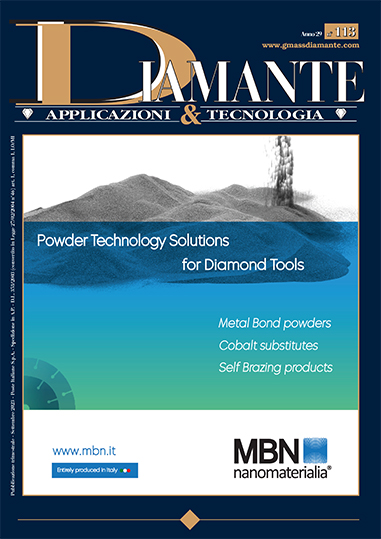|
Diamante A&T Contents Year XXIX - September 2023 |
|||||
|
Front Cover: MBN NANOMATERIALIA S.p.A. MBN Nanomaterialia offer to the market innovative materials for several applications in powder metallurgy, surface technologies and laser deposition sectors.
In the Spotlight 10) MBN Nanomaterialia: innovative metal powders for enhancing diamond tool performance 12) The value of time, SD Diamant nearly 60 years of experience 18) Workdiamond, stronger than ever 22) Global Stone Congress 2023, 7th Edition in Batalha Portugal Diamond Tools 28) Practical guide to free sintering in diamond beads production (part 8) by O. Cai
7.1) QUALITY CONTROL IN THE PRODUCTION OF DIAMOND BEADS 43) Grinding behaviour of metal-bonded diamond grinding wheels with an additive of chromium as a carbide-forming element by B. Denkena, B. Bergmann, R. LangLeibniz Universität Hannover, Institute of Production Engineering and Machine Tools, Garbsen, Germany
Abstract: Addition of carbide-forming elements to metal-bonded diamond grinding wheels can increase the grain retention through
carbide formation at the grain-bond interface. In order to investigate the effect of chromium addition, bronze-bonded diamond grinding wheels were fabricated through
field assisted sintering technology. The resulting grinding layers were characterized by means of critical bond strength, hardness and density. At a sintering temperature of 720°C
no carbide formation within the interface of diamond and bronze-bond was observable. The chromium particles with an average diameter of 10 ?m remain unreacted und evenly
distributed within the grinding layer after sintering, resulting in no significant increase in grain retention forces. Nevertheless, the chromium addition leads to a decrease of
ductility of the bond, resulting in a grinding wheel surface topography were diamonds are more exposed and the bond is further recessed after machining. The thus emerging higher grain protrusion results in an
improved grinding behaviour with a decrease of near 100% in process forces and increase of 446% in G-Ratio. Stone 53) The original stones and the cultural heritage conservation by R. BrunoDepartment of Civil, Environmental and Materials Engineering, DICAM, University of Bologna
Abstract: The world cultural heritage recognized by UNESCO is largely based on monumental assets characterized by the use of stone.
In many cases, replacement of the compromised elements is inevitable. In Italy, the first country in the world in terms of number of world heritage sites, the maintenance of monuments
requires guaranteeing extraction activity to support extraordinary maintenance and restoration. For sustainable conservation of cultural heritage, a policy is needed that guarantees the activity
of specific quarries for the supply of original materials. In case of conflict between the need to conserve natural and cultural heritage, it is a question of establishing priorities and
proposing solutions such as, for example, artisanal mining. The conflict between of the two conservation needs, natural and cultural heritage, and the possible solutions require supranational
legislative interventions (EU, UNESCO). Elettronics 65) Metal diamond composites - A way for industrial production and material integration into power module by T. Hutsch1, M. Rittner2, T. Zetterer3, T. Weibgarber1, 41 Fraunhofer IFAM, Branch Lab Dresden, Germany 2 Robert Bosch GmbH, Germany 3 SCHOTT AG, Germany 4 Technical University Dresden, Institute of Materials Science, Germany
Abstract: The ongoing development of power modules for electronics in the field of electromobility, charging infrastructure and
photovoltaic based on SiC chips come up with a strong demand on tailored thermal management materials with high thermal conductivity, tailored coefficient of thermal expansion,
soldering workability and a way for industrial production. In this paper the developed routine for the industrial production of metal diamond composites inspired by the wafer technology
for semiconductors will be presented using the example of copper diamond composite. For the material integration into power modules by soldering the composite needs a cover with pure copper on both sides. The cross section, thermal
conductivity and coefficient of thermal expansion will be displayed for the single composite, the covered composite and after integration into active metal braze (AMB) substrate.
Aspects for the further integration into a power module design will be discussed and shown for one example. News and Events 74) In the first quarter, machine tool orders went down (-21.8%). Domestic orders (-38.3%); foreign orders (-10.5%) 80) 9th edition of the international INTERMAT Innovation Award 2024 competition 82) Rocalia 2023: three days of full immersion in the natural stone industry |
|||||

